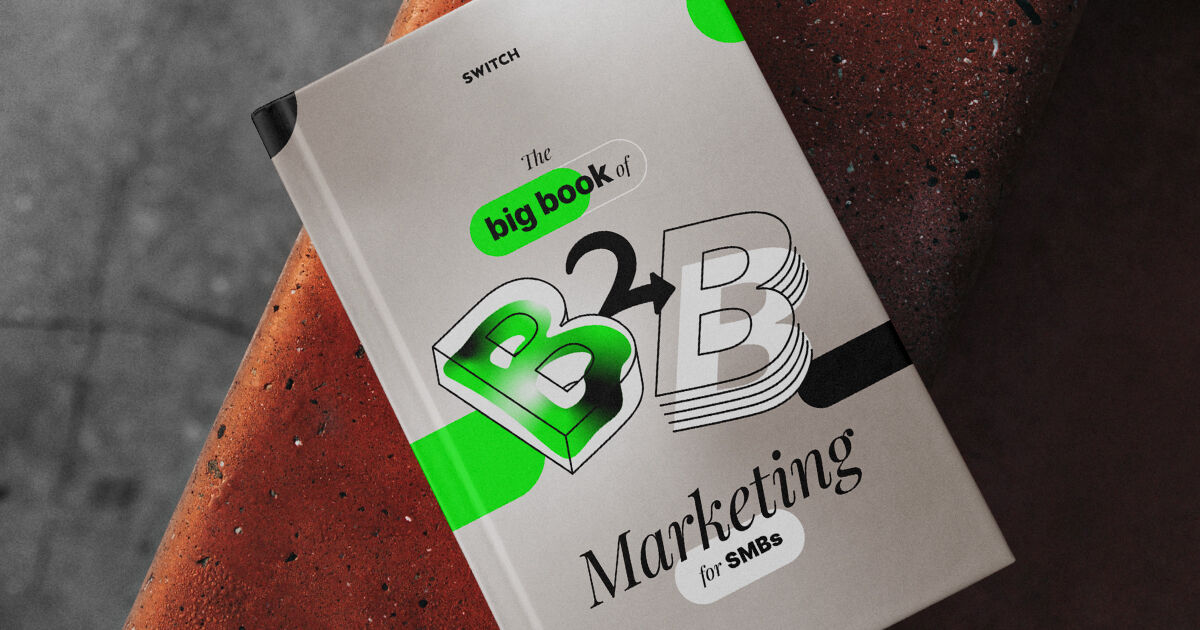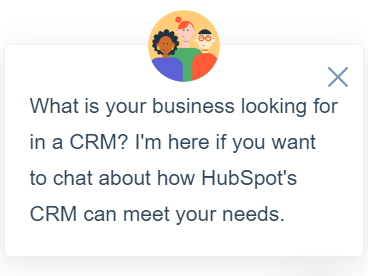Before we get started with our B2B Marketing Trends 2023 article, we want to share another free resource for B2B companies – our newly published Big Book of B2B Marketing. Nearly 200 pages of insights and ideas from decades of combined experience – all for free.

2022 did not go as planned.
2023 is set to be more of the same.
For B2B, that means more complications, more urgency, and more importance towards making your B2B communications really matter.
This will be the year in which trends that have been percolating for a while on the outside will slowly start to take centre stage. The year where the big social media platforms will be challenged to compete with, and against, smaller companies with more flexibility and a better algorithm. The year where B2B communication has to be given the same importance as B2C communication.
2022 started the wheel rolling by pushing B2B brands to think about the way they communicate.
2023 is going to make them think even more deeply about that.
Here’s how.

A Global Snapshot
B2B marketing is a multitrillion-dollar industry.
It also lags behind B2C marketing in terms of approach.
B2B marketing is boring. B2B marketing has to follow the rules. B2B marketing can only serve a single purpose.
In 2022, these arguments started to show the weaknesses this kind of thinking led to. B2B marketing as a field struggled post-pandemic – both to connect with the same consumers as before, and to strive forward the way other industries managed. From social media to marketing in general, they saw a way forward and beyond the limitations imposed by the pandemic and the years following.
As a result, B2B marketing has a banner year of change ahead of it – both client-side and agency-side.

What’s here to stay?
Change is happening.
But there’s one aspect of B2B marketing that is going to lead the march into 2023 and beyond.
Don’t be a dick.
B2C communications have already internalised this idea. Consumers are flighty, quick to change their favourite brand if it means a new one will better fit their values, and not forgiving – they don’t need to be. With so many brands offering same-or-similar services, the global marketplace is competitive enough that they can shop around.
For companies that stick to older ways of thinking, and working, there is the big problem with tradition. Companies that persist in creating environments where workers and customers are both considered less than profit will find that it doesn’t serve them well – and that the outcome of this sort of narrative is less and less likely to produce the lasting relationships that any brand needs to survive.
Values are important. In an era where customers see purchases as extensions of their own reality, they are the most fundamental ways for consumers to show where they stand and what they stand for. If your company doesn’t behave in a way that supports their views, your company has a limited time left in their esteem.
You might think it is only one consumer.
It isn’t.
The internet has become increasingly black and white, for or against. The outcome of this kind of thinking is that there is no room for grey or nuance, so even if your company tries to cover some of the bad news with good, it might not work unless you’re willing to change, make sacrifices, and admit your mistakes.

What changed in 2022?
Business practices as we know them took a significant hit in 2022.
Quiet quitting. Act your wage. The Great Resignation. Recession worries. Changes to several data laws. New technology.
Modern businesses have a global marketplace to use and a global workforce to contend with, and any change in the working world sends ripples through every other industry. It isn’t just a case of having a customer-facing side that looks pretty and has the right components for PR: B2B businesses have to also work well internally.
And they have to diversify how they communicate to reach the audiences they need to reach.
We’ve been watching B2B communication fragment for a while now, partially because of the way that social media has changed. Over the years, as Facebook numbers have decreased, businesses have gone on to experiment in other platforms, shifting their strategy wholesale from Facebook to work on Instagram or Twitter, usually without making changes to the actual campaign.
In 2023, that is no longer going to help your B2B communications – and businesses need to learn to put out content and communications that bring into the fold a thousand other methods of connection. Facebook is no longer the only social media platform worth running business campaigns on.
Try LinkedIn. Try Instagram. Try Reddit.
Fragmented communications were always going to be the outcome of a social media-based internet. However, 2022 has really escalated the need to establish a business on more than one platform and to build a following for your brand – no matter what your brand is.
Especially if your brand is B2B. You might be speaking to companies, but the B2B buyers you’re speaking to are human.
So you have to communicate with humans. And to communicate where those humans are found.
Trends 2023

Return to (Internet) Roots
Trend 1: Slower communications yield faster connection.
Who even uses e-mail anymore?
Everyone in the working world.
It’s ironic that in the state of 2023 where we have instant connection via Zoom, Chat, Slack, Facebook, Instagram, Whatsapp, and others, the method of communication that seems to be doing the best way of connecting is e-mail: still instant, but in a far more sustainable, timely way. Part of the reason for e-mail’s renewed popularity is the other side of the coin we have become used to: instant messaging where connection becomes a game of chance against everything else that demands our attention. Part of it is e-mail’s capacity to support business.
In 2023, e-mail as business communication is going to prove its worth as a channel where good marketing can thrive. Similarly, slower forms of communication such as websites and forums are also going to see an increase in use. Nostalgia is a heady driver for multiple industries, and the sudden turn towards the early days of the internet where communication was slower is the natural progression of a hyper-connected industry that has gone speeding ahead since the early days of social media.
Slower communication is in. Slower communication with less focus on what you’re selling is even more fundamental. From forums to personal websites to e-mail, deeper connections are driving B2B communication in 2023.
And there’s a hell of a lot of fun you can have with that.
Statistics:
- There are over 4.14BN email users worldwide.
- 87% of marketers send their content through email.
- Over 333 billion emails are sent per day.
How do I use this trend?
Invest your time in your email.
It’s true that it’s long been the province of spam messages and marketing emails that get deleted without being read. It’s also true that the court of public opinion has swung back to emails.
But as with all strategies, good email marketing doesn’t manage in a vacuum.
So before you start sending your content via email, you have to think of this: do you have content worth sharing? And can it be shared in an email without taking up a lot of valuable time for the people who’ve opened it?
Just putting your content in an email isn’t going to help you.
Putting content that’s enjoyable, easy to understand, and fast to get through is.

Who did it best?
Grammarly, a cloud-based typing assistant, frequently sends out emails to its subscribers that talks about their upgrades, premium services, and new offerings. Their emails are on the longer side, especially for newer users, as they guide you through the brand and their brand purpose, but every aspect of their email is carefully crafted to reduce churn. It also sends ou weekly updates on how your writing is improving, or where you can make changes.
Additionally, Grammarly adds a gamification element to its emails. Use Grammarly for long enough, and you start unlocking achievements, each with its own badge. There’s even an achievement if you’ve installed Grammarly and stopped using it, encouraging you to come back and resume your use of Grammarly.
It’s fun, easy to read, and playful – everything you want in an email campaign.

Behind (Accessible) Closed Doors
Trend 2: Gated, long-form content as community building.
The old adage, ‘you don’t get something for nothing’ is very relevant when it comes to B2B communication – but it doesn’t have to limit what you can provide and the way you connect with your audiences.
B2B brand investments are complex. B2B buyers need to know that the investment they’re making in your brand is salient enough to provide the same level of value that they’re looking for. Additionally, if all you ever speak about is your client work, the communication you put out on your socials is going to be limited, and you won’t showcase the full depth of your expertise.
However, it doesn’t need to be content that you provide entirely free.
eBooks and gated content are a good way of getting your brand’s content out there, but getting something back in return: an email for your database, a subscription to your mailing list, a way of harvesting data first-hand.
There is a caveat, and it’s the one we’ve been repeating for a while: your content has to stand up to the subscription.
It isn’t enough to offer gated content. You have to offer valuable gated content, and something that is worth the price of admission.
This means putting work into creating content. This means making content a key aspect of your brand.
And it means taking the time to design, publish, and advertise your content as something that you put thought and effort into, rather than as a way of just keeping your social media platforms alive.
Statistics:
- Gated content makes up 27% of all blogged content.
- 49% of marketers consider downloadable content as beneficial for lead generation.
- 83% of marketers see quality over quantity as valuable for content marketing, even if it means posting less often.
How do I use this trend?
There’s no way around this trend except by putting out more content: content that reflects the best of your company. Content that you put time and effort into. Content that might not be relevant, but puts out information that’s worth knowing.
Content that teaches. Content that is worth subscribing for.
Content has always been relevant; it’s the reason why so many people flock to certain social medias above others. This also means that they’re inundated with content above and beyond what they can take in, and so picking and choosing what content to focus on has become the norm.
Gated content strikes a good balance between being the content they can focus on and providing a break from constant, overwhelming streams of information – but it has to be content worth the subscription or the download or the time spent getting past the gate.

Who did it best?
Trendwatching is a leading trend-watching platform focused entirely on consumer trend research – and it shares some of its research freely.
Hop onto the Trendwatching website, and there’s a section dedicated entirely to one new trend a day, a monthly trend, and a Miro-based framework that you can use to understand hard-to-parse consumer trends.
The real value of Trendwatching’s services, however, lies in its gated content. All of the above is offered free of charge as a taste of what Trendwatching actually keeps behind its gate: annual trend reports, valuable keynotes and workshops, training courses, and industry forecasting. They also offer access to an innovation database with over 28,000 researched innovations, and analyst support to help you analyse the latest trends.
Additionally, if you want more access to trends without necessarily subscribing to the platform, Trendwatching offers free research through email subscriptions, sending you one beautifully-designed email a week to keep you updated on the latest trends.

Better By Example
Trend 3: Environmental social governance as a cornerstone of the brand.
There’s no way to say this nicely: you need to get your fucking shit together.
In 2022, the big overarching megatrend was ‘don’t be a dick’. Not only is that still relevant (we mentioned it way up in the beginning, so scroll back for a reminder), but we’ve gone one step beyond not being a dick for pure optics.
And it doesn’t mean your brand has to have some higher purpose if all you want to do is make lots of money.
But you have to treat the people behind your brand – your workers, primarily, but your customers, your contacts, your freelancers – in a way that matters. You have to have a set of rules that you adhere to. You have to behave in a way that makes you honest, believable, and at the very least, understandable.
Environmental, social, governance: the way your brand behaves regardless of whether it leads to higher profits or not. The internal compass that guides your behaviour. What you wake up for in the morning.
We’ll be clear: this doesn’t mean everyone will like your brand. It also doesn’t mean that the metrics you value are valued by others – but it does mean that you’re honest about your intentions, and that honesty will favour you better than using ESG as a bandwagon will.
Here’s the thing: B2B communication is fundamentally rooted in honesty. Setting any ESG promises for any aspect of your brand is going to rear back and bite you if you’re only in it for the purpose of getting a better standing in the eyes of your competitors and your community.
People take their internal values seriously. They take honesty even more seriously – especially now where the price for dishonesty is a loss of business.
In 2023, we’re going to see a lot more businesses pivot away from CSR and hop onto ESG. Every brand that’s had a bad news cycle in the last period is going to bring out stories about how it’s changed and how it’s going to improve the way it works and how it supports valuable causes.
For most of them, that will be true.
For the few that are going to use ESG as a PR smokescreen: don’t. Consumers – and that includes B2B buyers – are tired of being lied to. And if you set your behaviour as one way, and you act differently to those behaviours, you’ll find out the hard way that it doesn’t work for long.
Statistics:
- 91% of businesses think it is their duty to act on ESG.
- 88% of investors look at ESG as critical to making their decisions.
- 81% of business leaders consider ESG fundamental to their company strategy.
How do I use this trend?
Don’t be a dick.
We can say this in as many words as you like, but it all boils down to one thing: if you’re an asshole, there’s nothing you can do to use this trend in any way that matters.
If you want to make real, lasting change to your organisation, if you want to improve the way you work for the better, start inwards. Improve the lives of your employees. Improve the way you work with your vendors. Work on sustainability measures that actually matter. Don’t offer perks: offer a work-life balance that your employees will value.
Don’t be a dick.

Who did it best?
Ahead of the World Cup qualifier at Hamden, Duolingo launched a campaign to show support for Ukraine following the invasion of Russia. Scotland would be playing Ukraine for the qualifier, and so Duolingo and creative agency The Romans brought ESG to the football ground.
Working with a Ukrainian opera singer and Duolingo’s translation team, they phonetically transcribed the State Anthem of Ukraine in music sheets to hand out to football fanatics entering the grounds. Scottish football fans are known for their passionate renditions of Flower of Scotland ahead of every match, so by channelling that passion into their opponents’ anthem, Duolingo created a powerful campaign for peace.

What Happens Next?
Trend 4: Post-sale marketing for continuous connection.
You’ve put out good content. You’ve made a sale.
Now what?
It’s tempting to go back to low-effort content that frees up your time to focus on making different, other sales.
That is precisely what you shouldn’t do.
When you put time and effort into advertising your content before you’ve ever built that connection or made that sale, the difference is notable. For better or for worse, you’re going to put out content that especially provides value, and while it will take up more of your time, the payoff is going to make that time worth it.
Now think about taking a step back from that and providing the kind of content that is easier to put together – but might not have the same level of value.
For 2023, post-sale marketing is going to be just as important as the marketing that gets you that sale in the first place. It’s the latest escalation in how consumers look at brands: not just as temporarily brilliant, but as constantly putting out valuable content that will keep them going back for more.
Statistics:
- Users targeted with relevant content are up to 72% more likely to convert.
- Companies that excel at lead nurturing generate 50% more sales-ready leads at a far lower cost.
- 83% see a significant difference in sales opportunities from nurtured leads.

How do I use this trend?
If all you care about is making a sale, you need to change the way you think.
This goes far, far deeper than sales.
This is brand. This is how you make sure your company gets the reputation it needs: not just for selling the most, but for the aftersales service, for being there when you need it, for being supportive, for understanding. B2B communication doesn’t get a pass on human just because it’s business to business – far from it.
It needs to be there for its clients.
So don’t focus on sales. Focus on connecting with your clients, on offering content that bridges the gap between you and them, on creating an aftersales service that really emphasises your good points.

Who did it best?
We have to hand this one to our CEO.
Our content cycle usually means we’re producing and publishing content on a regular basis – not just on our own blog, but on our social media platforms and our personal social media platforms in kind. In addition, our CEO sends out a newsletter every couple of weeks about what’s going on in the company.
And he replies to the responses that he gets personally.
Replying to emails falls far down on the list of priorities for anyone, especially if you’re running an organisation, but connection and communication are two of the most important building blocks for Switch, and so if you email Switch, you will get a reply, no matter what.

Best of Both Worlds
Trend 5: Hybrid events to capitalise on brand building.
One of the best things that came out of the pandemic was technological: the ability to connect with, and engage with, events that happened all around the world. From music concerts to art showcases, hybrid events and online events skyrocketed – and while the need to hold events online has lessened, hybrid and online events offer a significant benefit that purely real-life events cannot.
That is to invite everyone, no matter where they are, at no cost and no additional strain.
On paper, and in practice, hybrid events and online events have an unmatched capacity for networking and brand-building that real-time events struggle to maintain. Not only do real-time events bring in additional costs for hosting and activities, attendees of these events also have to factor in their own budgets, which can put the event out of reach for several attendees – especially now that the rising cost of living crisis has become a primary concern.
In 2023, more B2B marketing events are going to be conducted online, either as hybrid events or as solely online events.
Statistics:
- 86% of B2B companies see positive ROI from their hybrid events.
- 30% of marketing events held in 2022 were hybrid events.
- 47% of event organisers see hybrid events as a good opportunity to connect international audiences.
How do I use this trend?
You don’t have to go full hybrid event to start with, but think about inclusivity. Part of the lure behind hybrid events is that it’s far easier to include everyone, no matter where they’re located. As the threat of a recession continues to mount, this is an underrated aspect of marketing that tends to be forgotten.
However, not every organisation is going to have the budget to put on massive webinars or host hybrid events.
So think smaller. If you hold events, publish your findings in a free-to-read PDF. If you run a research campaign, make it available in a blog or a podcast. These are lower-cost alternatives that can really unite your global audience – not just the ones who cannot attend, but the ones who might struggle to understand clearly what’s being said throughout the event.
Who did it best?
The ICOM network – which we form part of – has pivoted almost entirely to hybrid events since COVID-19 shuttered event spaces around the world. While all their events have an in-person component – usually held in the offices of an ICOM partner – they’ve also focused heavily on making the content accessible and available to all of their global partners.
Their latest event, Ravid Kuperberg’s webinar on decoding creative thinking, was split into two sessions to support the differing time zones, with one session held at 10AM for the European/MENA/AFRICA/APAC, and another session held for North America and the Latin Americas.

AI(ming) for Leads
Trend 6: Using AI for improved data collection and lead generation.
AI in B2B: it seems like it goes against everything we’re saying about building human connections and having human conversations.
However, AI has its place in current B2B strategy, and this place is this: helping to generate, automate, and collate a lot of the information-intensive practices of B2B and freeing up time to pursue other leads. Automating part of your B2B practice gives you more information to go off of – and as first-party data starts to supersede third-party data practices, more information can only be a good thing.
In 2023, AI is going to embed itself in B2B practice as one of the tools that best showcases the human element of B2B: that of connection and conversation.
Statistics:
- 84% of digital marketers see AI as a good way to deliver personalised experiences to customers.
- 64% of marketers see AI as crucial to their sales and marketing strategy.
- 73% of marketers consider AI the key to market leadership.
How do I use this trend?
Start by looking at your organisation. There’s going to be at least one area where you can benefit from AI, even if it’s just automating your responses to inquiries on social media.
That said, investing in this trend also means making sure that whatever AI you invest in doesn’t take the place of your human connection.
It’s not meant to replace you. It’s meant to optimise your operations: the way your website runs, your initial interactions with a customer, the way you come up with your SEO. AI can’t replace a good copywriter, an excellent designer, or a researcher that really knows their stuff: it can only simplify and automate what you already know.
Keep that in mind when you’re investing.

Who did it best?
Hubspot’s had their chatbots for a while, but they’re worth taking another look at.
As one of the most popular CRM platforms available, answering every customer inquiry and question would take up too much time for Hubspot to engage in, and so they’ve gone the route of automating some of their responses via chatbots – but keeping their automation very light and easy to retain a lot of that human connection.
The HubSpot bot only facilitates connection between you and the sales team. It asks you for an email in case you get disconnected, but actually connecting with a sales agent only takes a matter of seconds. You don’t have time to get bored or to lose your interest in the service, and connecting you with an agent instead of allowing the bot to do the heavy lifting adds a personal touch to communications that is hard to find in automated chatbots.

B2B is Human
Your B2B marketing practice is geared towards addressing brand requirements.
But the people you speak to and connect with are human, with human concerns, affected by the same reality that the rest of us are in. Those concerns can’t be kept separate from business: they’re part and parcel of the business world today. Ignoring the human side of B2B businesses to purely address the business side of B2B is the wrong move.
Here are some concerns to keep in mind for 2023.

Risk and reward
Cost of living is going up. The prices for everything are going up.
B2B buyers have to keep budget in mind now even more so than before – and that means cutting back on services that either don’t serve their new needs or can’t meet them on a price front. Remember: B2B buyers are just as human as a B2C audience, and the stakes for B2B buying are a little bigger than just purchasing a service that doesn’t quite do what you want it to. With several companies already trying to decrease their operational costs wherever they can, the last thing B2B buyers want is to tussle on price.
Companies that persist in providing a service without the capacity to meet their client’s requirements are not in the wrong – but with budget concerns, freemium and pay-as-you-go services might prove a growing niche.

Metaverse, Web3, and NFTs
Look: Web3 isn’t doing great. It’s not doing badly.
But for the climate that we’re in and the reality that we’re working with, the metaverse and Web3 is unattainable – for now. This doesn’t mean that it’s not worth keeping an eye on for the future, but at the pace it’s going, B2B buyers might prefer to avoid the minefield that is investing in a new industry.
However, there’s a bright side: innovative approaches to the use of technology aren’t going anywhere. In fact, as businesses become increasingly hybrid, companies that can provide a tech-led solution to their B2B clients will see a difference for the better.

CEO, Entrepreneur
We’ve spoken about this in another article, but it bears repeating: your CEO needs to be at the centre of your communications.
And your CEO needs to be someone worth following.
It’s true that the myth of the unreachable CEO has given businesses a lot of leeway to leave upper management to their own devices, but the tide has been turning away from the unseen CEO for a while – and the reality now is that CEOs that speak out can use their traction and their pull for a lot of good.
Provided that what they say is worth listening to. And provided that they lead in a way that appeals to the B2B buyers making the decisions. The recent rash of news about celebrity CEOs has only ushered in the idea of the visible CEO even further, and B2B buyers in 2023 are definitely going to keep an eye out for CEOs that speak out.

Fans and Friends
Word of mouth has always been a powerful tool for B2B. Do a good job for a client and they might bring you back for repeat work; do an excellent job, however, and they’ll recommend you to everyone they think could benefit from your services.
Influence is powerful. Influence from people you trust is why social media influencers move products so well.
B2B influencers can prove interesting content in the market, and now is the time to add a roster of trusted B2B influencers to your listings – and to start using them without delay.

Business as usual
Here’s the thing: business hasn’t changed, really.
The way we think about business and the people within it has. More to the point, it has moved in the direction that we were always going to move in, with businesses becoming more transparent, and the treatment of people and their consumers becoming near enough synonymous with their brand reputation.
For B2B, this is no different – and it starts with the employees. Companies that treat their employees well (and no, providing free lunch and perks a-plenty isn’t the same as treating your employees well) are going to see a greater interest from B2B buyers looking to invest in new services. Given that your employees are the biggest asset to any business, it’s not surprising that B2B buyers are looking for what matters: not only price, but a business that meets them on the value front as well.

Conclusion
2023 isn’t going to look different from what we already know when it comes to B2B.
But the way we look at and conduct business is vastly different from what we’re used to, and while B2B marketing has taken longer to come into its own than other industries, but the changes we’re seeing now stem from a long history of seeing what works for other communication strategies and experimenting to bring it into B2B communications.
It is not the easiest change to make.
But it is absolutely a necessary, and important, change to start working on. The more the borders shrink between businesses, the more competition grows, having a B2B strategy that addresses the human side of business matters – and it’ll matter even more as the years go on.
Needs some help figuring out your B2B strategy for 2023 – just get in touch.




